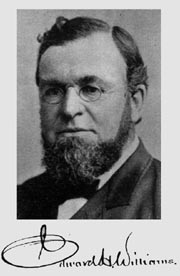Edward H. Williams
| Edward H. Williams | |
|---|---|
 |
|
| Born | June 1, 1824 |
| Died | December 21, 1899 (aged 75) Santa Barbara, California |
| Education | Vermont Medical College |
| Occupation | Physician, railroad executive |
Edward Higginson Williams (June 1, 1824 – December 21, 1899) was an American physician and railroad executive noted for his philanthropy.
Williams was born on June 1, 1824 in Woodstock, Vermont to Vermont Secretary of State Norman Williams and Mary Ann Wentworth (Brown) Williams. He graduated from Vermont Medical College and worked for a time as a physician. While living in Cavendish, Vermont he was the first physician to see brain-injury survivor Phineas Gage after Gage's famous accident. Williams later became a member of the Royal Swedish Academy of Sciences and was decorated as a Knight of the Order of the Polar Star.
Williams gave up medicine to work in the railroad industry. He left Vermont and resided in the Rosemont section of Philadelphia. Williams became well known in the U.S. for his work with the firm of Burnham, Williams, & Co. In 1870 he joined the Baldwin Locomotive Works.
In addition to his railroad activities, Williams also served as a U.S. commissioner to the Sydney International Exhibition in 1879 and the Melbourne International Exhibition in 1880.
Williams gave prominently towards education. He constructed and equipped buildings for the teaching of science at Carleton College (dedicated in memory of his son William) and the University of Vermont (in memory of his wife). He also made large donations to the University of Pennsylvania and other educational institutions. Williams donated a library building to his hometown of Woodstock, Vermont as well.
...
Wikipedia
